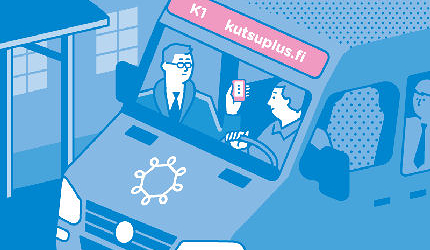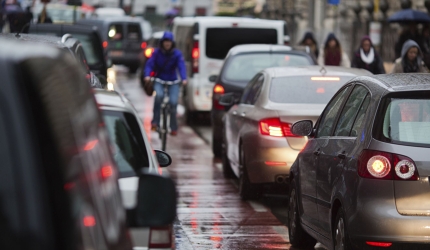Why city travel will never be the same again
A transport revolution is taking place in the Finnish capital, promising to change the way we travel around our cities. Gavin Haines heads to Helsinki to find out more.
The booze is wearing off, it’s starting to snow and I’m lost in Helsinki. In the pre-smartphone epoch this situation may have marred a fine evening in the Finnish capital, but thanks to a pioneering rideshare service, which can be summoned at the tap of a finger, I can relax, safe in the knowledge that a climate-controlled vehicle will be picking me up shortly. Apparently, it’s just a minute away.
No, I’m not talking about Uber – the San Francisco-based taxi company that’s irking cabbies the world over – but a groundbreaking bus service that is quietly revolutionising transport in the Finnish capital, and possibly beyond.
Dubbed Kutsuplus – Finnish for ‘call plus’ – the service offers on-demand, point-to-point bus travel for its subscribers, and promises to change the concept of public transport forever.
The white and blue minibuses are run by the Helsinki Regional Transport Authority (HSL) and are equipped with a pioneering technology called Ajelo Ride, which was developed by a local startup called Ajelo.
So how does it work? Well, those wanting to use Kutsuplus must first register online and put some credit in their account. This takes all of four minutes.
Then, when the time comes to use the service, all users have to do is whip out their smart phones, log on and tell Kutsuplus where they want to go. Ajelo Ride will then use algorithms to identify the minibuses best placed to make that journey, based on their location and the destinations of their passengers.
The user then chooses their favoured service – a decision usually influenced by time or cost – and the bus is rerouted to pick them up.
The Ajelo system is constantly forming and reforming routes for each bus, aggregating user requests in real time and calculating a journey that most closely satisfies all passengers. The service is considerably cheaper than taking a taxi (€2.80 base fare plus €0.36 per km), but more expensive than conventional buses, which charge €2.50 for a single ticket. Journey times are roughly the same as they are in a cab.
 Algorithms form and reform routes to best suit all passengers
Algorithms form and reform routes to best suit all passengersKutsuplus
Stepping up a gear
True to its word, my bus arrives after one minute. The door hisses open and a moustachioed driver requests my passenger number, M9, which was sent to my phone. I show it to him and he invites me aboard.
Displayed on a screen at the front of the bus, next to my number, is my destination, Kauppatori (or ‘Market Square’), and the estimated time it will take us to get there: 7 minutes. There is one other passenger on the bus, a young lady, and her destination is listed above mine on the screen.
En route to Kauppatori we pick up another passenger – a detour so seamless I fail to notice – before arriving at the Market Square, where I disembark and bid farewell to my driver and his tache. No cash exchanges hands; quietly €5.48 disappears from my online account.
It’s certainly a slick operation, but is it a glimpse of the future?
“That’s the idea,” explains Teemu Sihvola, CEO of Ajelo. “Our vision has been to revolutionise urban transport… and we aim to utilise this technology outside Helsinki and implement it in other cities.”
There are, of course, obstacles. Although HSL plans to have 2,000 buses on the road by 2020, there are currently just, ahem, 15. That’s hardly enough to service the needs of a capital city, even a small one like Helsinki; on a bad day users could be waiting up to 45 minutes for a ride, which is long enough to catch hypothermia.
“Our partnership with HSL has been really good for us – they have been really innovative and showed courage to pilot this revolutionary system – but their ability to ramp it up has been not in the realms that we would like,” says Teemu. “It needs to be ramped up faster.”
However, expediting the technology might be a step closer after Ajelo’s acquisition last month by the Washington tech firm, Split, which plans to expand the technology to incorporate other transport options such as trains, ferries, shared bikes and taxis. Both companies are coy when it comes to details, but Teemu believes Ajelo’s technology will be appearing in other cities soon.
“The idea of mobility as a service is a hot topic around the globe and many cities are interested to be at the forefront,” says Teemu. “Split shares our vision and together we are much better positioned to be providing technology for the revolution.”
 Helsinki authorities want to make car ownership pointless by 2020
Helsinki authorities want to make car ownership pointless by 2020Christian Müller / Thinkstock
NEED TO KNOW
Getting there
Finnair (www.finnair.com) fly daily from London Heathrow to Helsinki Vantaa Airport.
Getting around
Kutsuplus offers affordable (€2.80 base fare plus €0.36 per km), point-to-point minibus travel around Helsinki. The on-demand service has excellent city centre coverage, but shows its limitations in the suburbs. Journey times are comparable to that of a taxi. Single fares on a conventional bus or tram cost €2.50 and all day travel cards can be bought for €8.
Further information
Kutsuplus (www.kutsuplus.fi)
Ajelo Ride (www.ajelo.com)
Do you have any Feedback about this page?
© 2026 Columbus Travel Media Ltd. All rights reserved. No part of this site may be reproduced without our written permission, click here for information on Columbus Content Solutions.









 You know where
You know where